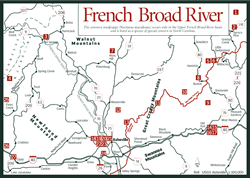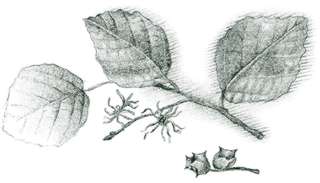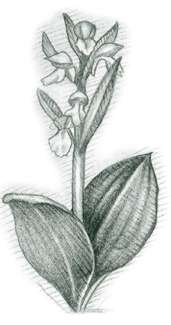 French
Broad River Area
French
Broad River Area  French
Broad River Area
French
Broad River Area [Fig. 21] The French Broad River is the largest watercourse in Western North Carolina. First settled by members of the Cherokee Nation and visited in 1540 by the treasure-seeking Spanish explorer Hernando De Soto, the river basin was ultimately occupied by English-speaking settlers. They gave the river its often-misunderstood name because it flowed west toward the Mississippi Valley lands claimed by French explorers and fur traders. With a rich and varied history, the river has had a major influence on human activities in the area and continues to do so today.
From the river's headwaters west of Rosman in Transylvania County to the border of Tennessee, the French Broad is about 70 miles in length. Its drainage basin includes 5,124 square miles, with 1,664 square miles occurring in North Carolina. At its highest elevation, the French Broad River reaches 6,400 feet, where one of its major tributaries, the Swannanoa River, begins below Potato Knob in the Black Mountains. The river's lowest North Carolina elevation, 1,240 feet, occurs at the Tennessee state line west of Hot Springs.
The French Broad River has several characteristics that are unusual for rivers of the southern Appalachians. Due to the nature of southeastern Blue Ridge topography, the river flows in a northward semicircle, cradled between the Tennessee Valley Divide and the Pisgah Ridge. Beginning at the junction of its first three major tributaries, the North, West, and East forks, the river flows first to the northeast, then turns north to Asheville, and finally sweeps to the northwest toward Tennessee.
Another of the French Broad's interesting characteristics is that it flows along a nearly level grade for much of its length. The river's southern portion has an average fall of only 3 feet per mile and, at some locations, as little as 1 foot per mile. This rate eventually increases between Asheville and the Tennessee line, where steeper gorges and narrower channels result in a fall of 16 to 30 feet per mile.
In addition, the river is wider by comparison than others in the region. The slow currents, together with the gently sloping topography, contribute to an expansive floodplain along the river's portion south of Asheville. This floodplain is especially wide in the area between the French Broad's junction with the Mills River and the Asheville vicinity.
Finally, the French Broad River occurs at a fairly low elevation, where winter temperatures are relatively moderate and summer temperatures approach those expected in the Piedmont and Coastal Plain provinces. This combination of geology and climate influences forest and animal species found along the river. While trees typically associated with the mountains such as basswood, tulip poplar, and various oaks are found here, so are a number of floodplain species—river birch (Betula nigra), sycamore (Platanus occidentalis), American hornbeam (Carpinus caroliniana), hazel alder (Alnus serrulata), and several species of willow.
A large variety of wildlife, especially birds, can be seen along the French Broad River, the most notable being the wading birds. Great blue herons are numerous, and green (Butorides virescens) and little blue herons (Florida caerulea) appear as well. Egrets, which make their way inland after nesting in Coastal Plain habitats hundreds of miles to the southeast, are a special treat in the mountains. These magnificent white birds can be seen searching for fish and crustaceans along the banks of the French Broad's quiet waters.
Other water birds include the black duck (Anas rubripes), pied-bill and horned grebes (Podilymbus podiceps and Podiceps auritus), belted kingfisher (Megaceryle alcyon), osprey (Pandion haliaetus), wood duck (Aix sponsa), and, occasionally, the spotted sandpiper (Actitus macularia). The southern bald eagle historically nested along the river and still can be spotted today. Migratory woodland and riparian birds commonly seen and heard in summer include the white-eyed and red-eyed vireo (Vireo griseus and V. olivaceus), hooded warbler (Wilsonia citrina), worm-eating warbler, yellow-throated warbler, northern parula warbler (Parula americana), Acadian and great crested flycatcher (Empidonax virescens and Myiarchus crinitus), Louisiana waterthrush (Seiurus motacilla), and various swallow species.
One of the best ways to see the wading birds and ducks is from the river itself. There is good access to quiet water stretches at Sandy Bottom near the Bent Creek area. For those lacking the proper equipment, outfitters offer canoes and rafts plus put-in and take-out shuttles (see Appendix C). Two-hour trips, for example, take visitors along an easy route with just enough Class I rapids to make this a relaxed but fun family outing. Paddlers are treated to views of floodplain forest and river-edge vegetation and wildlife, as well as the historic Biltmore Estate property and mansion. Sharp eyes will spot river otters, white-tailed deer, and perhaps turtles basking on sunlit logs. Colorful red skimmer dragonflies often hover above the French Broad's waters which sparkle with tiny flakes of mica.
West of Asheville, paddlers are treated to a totally different experience. Intense whitewater excitement replaces the relaxed drifting and nature study possible below the city. For whitewater enthusiasts, numerous parks (both city and county) provide access points from Asheville to Hot Springs. There are also a number of whitewater river outfitters in Western North Carolina that offer guided trips through the various stretches of rapids (see Appendix C).
 Once
polluted and nearly lifeless, the beautiful French Broad River has been rehabilitated
and now supports a wide variety of fish, including largemouth bass (Micropterus
salmoides), brown and rainbow trout (Salmo trutta and Oncorhynchus
mykiss), muskellunge (Esox masquinongy), and catfish. Riverlink,
Inc., a nonprofit community organization, has been spearheading efforts to promote
the health and use of the river, including converting former industrial areas
along the Asheville riverfront into parks, riverside shops, and other businesses.
Once
polluted and nearly lifeless, the beautiful French Broad River has been rehabilitated
and now supports a wide variety of fish, including largemouth bass (Micropterus
salmoides), brown and rainbow trout (Salmo trutta and Oncorhynchus
mykiss), muskellunge (Esox masquinongy), and catfish. Riverlink,
Inc., a nonprofit community organization, has been spearheading efforts to promote
the health and use of the river, including converting former industrial areas
along the Asheville riverfront into parks, riverside shops, and other businesses.
[Fig. 21(21)] The Colburn Gem and Mineral Museum, located on historic Pack Square in downtown Asheville, is one of the four museums of the Pack Place Education, Arts and Science Center. The museum showcases a diverse collection of gems and minerals from around the state and from numerous parts of the world.
Exhibits begin in the first room with a brief history on the development of the Dana Classification System of minerals. Along the left wall, various colorful minerals are grouped in classes labeled Halides/Borates, Carbonates, and Oxides/Sulfates, and there is an exhibit of crystallography, including an intriguing phenomenon known as "phantom" crystals. Between these exhibits are insets of specimens of the major mineral groups.
Separate floor exhibits feature beautiful, large crystals of emerald in its natural matrix, a quartz-aragonite that somewhat resembles an undersea finger coral, calcite crystals with sand inclusions, and a magnificent aquamarine weighing 376 pounds, one of the museum's premier possessions.
Another display features minerals that emit scintillating fluorescent tints when exposed to ultraviolet light controlled by the viewer. Nearby is another viewer-operated switch that demonstrates a sandstone that literally flexes without breaking.
Toward the rear of the museum, a popular permanent exhibit spotlights the minerals for which North Carolina is most famous. Entitled "North Carolina—The Gem State," this exhibit includes native emeralds, rubies, sapphires, and gold. The economically valuable spodumene, mica, feldspar, granite, olivine, and phosphate are also on display. A brief history of the nation's first gold rush, which occurred following the mineral's discovery in North Carolina, rounds out the exhibit. This area of the museum also has featured special or traveling displays, such as the Foster Sondley Gem Collection and the rarely shown Harvard Gold Collection.
The final exhibit room includes displays of cut and polished precious and semi-precious gemstones plus intricately fashioned articles of jade and lapis lazuli and examples of decorative and ornamental stones and pigments, such as those used in monuments, buildings, and paints. The left wall includes ores and minerals accompanied by derivative products in a display entitled "Resources of Modern Civilization."
The Colburn Museum holds two other outstanding exhibits. The world's largest star sapphire, the "Star of the Carolinas," is on view here. Listed in the Guinness Book of World Records, this black polished stone has a finish weight of 1,445 carats. Also displayed is a collection of the extremely rare mineral hiddenite.
The museum sponsors various programs and events, including lectures, teacher training, school outreach programs, field trips, mineral identification, and an annual mineral sale. The Starlab Planetarium also is operated under the auspices of the museum.
[Fig. 21(22)] In his epic autobiographical classic, Look Homeward, Angel, American novelist Thomas Wolfe chronicled his boyhood in Asheville and immortalized his mother's "Dixieland" boarding house where he spent many of his childhood years. The sprawling Victorian structure, located downtown, has been preserved almost intact, providing visitors with a glimpse of the experiences that shaped the legendary author—and of the memories that he kept alive in his work.
 Next
to the memorial, a newly opened visitor center features an audiovisual program
about Wolfe's life. In addition, an exhibit hall showcases the contents of the
writer's New York apartment and items from his father's stone monument carving
shop which also figured prominently in his writing. All in-print books by Thomas
Wolfe are available at the visitor center.
Next
to the memorial, a newly opened visitor center features an audiovisual program
about Wolfe's life. In addition, an exhibit hall showcases the contents of the
writer's New York apartment and items from his father's stone monument carving
shop which also figured prominently in his writing. All in-print books by Thomas
Wolfe are available at the visitor center.
[Fig. 21(25)] Beneath the high peaks of the Great Craggy Mountains is a valley that has inspired community, creativity, learning, and a sense of harmony with the environment. Evidence exists of settlement in the Swannanoa Valley as early as the Middle Archaic period (5000–1500 b.c.) Today, Warren Wilson College students and others from across the country study the culture of those settlers by participating in the excavation of one of the most significant archeological sites in southern Appalachia.
Best known as the location of a prehistoric Cherokee village around a.d. 1350, the site has been operated as an archeological dig since 1965. In 1996, the Eastern Band of the Cherokee Indians accepted an invitation from Warren Wilson College to become partners in the project, making it the first excavation in North Carolina working in conjunction with the Cherokee people to define and teach cultural sensitivity to future archeologists.